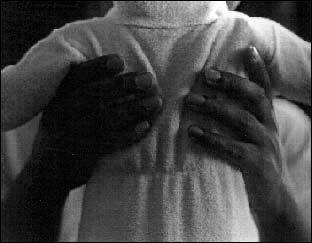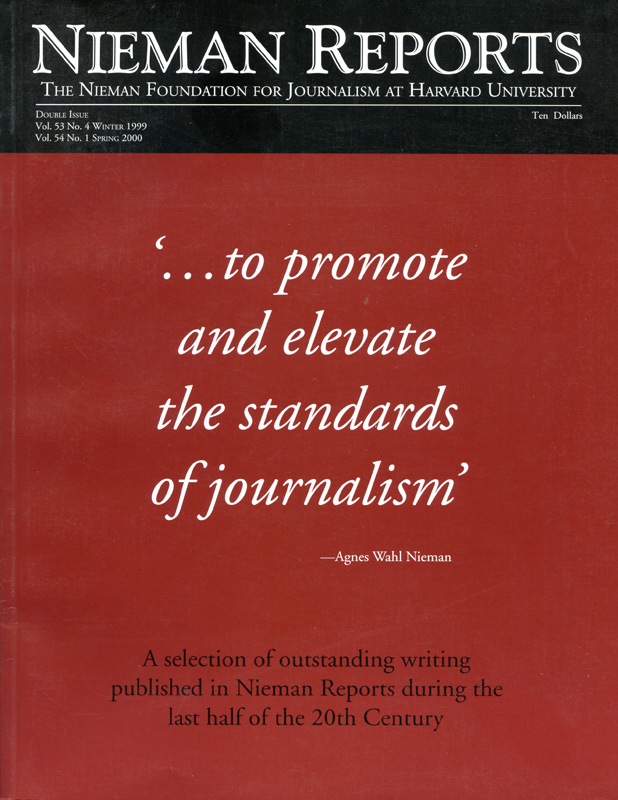[This article originally appeared in the Summer 1998 issue of Nieman Reports.]
Roy DeCarava doesn't occupy a space, he blends with it. But to say that his approach to photography is stealth-like is to attribute to him a potential for discord that does him a disservice. With DeCarava there is no hidden agenda; his is a harmonious presence. In his carefully composed black-and-white images of the common man, we are allowed to see the colors of shadows. Rich and evocative, they render his subjects in what one essayist calls "a reflective state of grace."
For close to 50 years, DeCarava has consistently explored one subject, New York City, primarily Harlem. It is this community that educated and nurtured him and provided this only child with a surrogate family among whom he always found a place at the table. To paraphrase the poet, unlike the smoke that forgets the earth from which it ascends, DeCarava never betrayed or strayed from what appears to be a solemn trust. The love and care with which he embraced this family is repaid in the access he is given to their lives. Through his images, we become part of his extended family.
DeCarava made a decision early in his career to chart his own course, "aspiring to his own values," as he puts it. It is a decision that has cost him dearly. Both his choice of subjects and his approach to his art would put him outside the commercial loop. As a professional, he would later do a two-year stint at Sports Illustrated; it was not a match made in heaven. For a man who believes in "listening to the moment," keeping his eye on the ball was not conductive to making good pictures.
But to suggest that DeCarava fails as a photojournalist is to confuse style with content. That he chooses to render his subject in what some consider an artistic fashion need not be taken as evidence that he abandoned the tenets of photojournalism. His pictures simply tell a story about a different black America, one that is not in a constant state of trauma. The results attest to a vision unencumbered by preconceived attitudes about his choice of subjects. Indeed, it can be argued that his pictures speak to a higher truth about his subject in a style that embraces their humanity rather than denies it.
At its best, photojournalism is simply a way of telling a story where the content of the images minimizes or exceeds the necessity for copy. DeCarava does this superbly, with an expanded, richer vocabulary. His nuances in shades of gray and black are his adjectives and adverbs used to describe his subjects and their condition, his four "w's" and an "h." If some of us see it as art perhaps it points to an unfamiliarity with the style and language rather than tampering on the part of the photographer.
In the profession of journalism, the photographer's contribution usually servers to augment or support the copy of the writer. It is the wordsmith who not only tells the story, but also sets the parameters for the photographer's participation. And if anything is to be cut, it is usually the pictures first. Picture magazines like Life and Look reversed that equation, and television totally changed things. DeCarava's approach to photojournalism, and his choice of subjects, set him apart at a time when the image-makers were encroaching on the turf of the writers.
That DeCarava found greater acceptance in the salon than the newsroom says a lot about the opportunities that existed for photographers who wanted their pictures to tell their own stories. And one who selected Harlem as his beat put limits on his acceptance and his options. Ultimately, great photojournalism ends up in galleries and museums. DeCarava got there early.
Lester Sloan, a 1976 Nieman Fellow, is contributing essayist to National Public Radio's "Weekend Edition" and a freelance photojournalist.

"Bill and Son, 1962," from "Roy DeCarava: A Retrospective." © 1962. Photo courtesy of Roy DeCarava.
Roy DeCarava doesn't occupy a space, he blends with it. But to say that his approach to photography is stealth-like is to attribute to him a potential for discord that does him a disservice. With DeCarava there is no hidden agenda; his is a harmonious presence. In his carefully composed black-and-white images of the common man, we are allowed to see the colors of shadows. Rich and evocative, they render his subjects in what one essayist calls "a reflective state of grace."
For close to 50 years, DeCarava has consistently explored one subject, New York City, primarily Harlem. It is this community that educated and nurtured him and provided this only child with a surrogate family among whom he always found a place at the table. To paraphrase the poet, unlike the smoke that forgets the earth from which it ascends, DeCarava never betrayed or strayed from what appears to be a solemn trust. The love and care with which he embraced this family is repaid in the access he is given to their lives. Through his images, we become part of his extended family.
DeCarava made a decision early in his career to chart his own course, "aspiring to his own values," as he puts it. It is a decision that has cost him dearly. Both his choice of subjects and his approach to his art would put him outside the commercial loop. As a professional, he would later do a two-year stint at Sports Illustrated; it was not a match made in heaven. For a man who believes in "listening to the moment," keeping his eye on the ball was not conductive to making good pictures.
But to suggest that DeCarava fails as a photojournalist is to confuse style with content. That he chooses to render his subject in what some consider an artistic fashion need not be taken as evidence that he abandoned the tenets of photojournalism. His pictures simply tell a story about a different black America, one that is not in a constant state of trauma. The results attest to a vision unencumbered by preconceived attitudes about his choice of subjects. Indeed, it can be argued that his pictures speak to a higher truth about his subject in a style that embraces their humanity rather than denies it.
At its best, photojournalism is simply a way of telling a story where the content of the images minimizes or exceeds the necessity for copy. DeCarava does this superbly, with an expanded, richer vocabulary. His nuances in shades of gray and black are his adjectives and adverbs used to describe his subjects and their condition, his four "w's" and an "h." If some of us see it as art perhaps it points to an unfamiliarity with the style and language rather than tampering on the part of the photographer.
In the profession of journalism, the photographer's contribution usually servers to augment or support the copy of the writer. It is the wordsmith who not only tells the story, but also sets the parameters for the photographer's participation. And if anything is to be cut, it is usually the pictures first. Picture magazines like Life and Look reversed that equation, and television totally changed things. DeCarava's approach to photojournalism, and his choice of subjects, set him apart at a time when the image-makers were encroaching on the turf of the writers.
That DeCarava found greater acceptance in the salon than the newsroom says a lot about the opportunities that existed for photographers who wanted their pictures to tell their own stories. And one who selected Harlem as his beat put limits on his acceptance and his options. Ultimately, great photojournalism ends up in galleries and museums. DeCarava got there early.
Lester Sloan, a 1976 Nieman Fellow, is contributing essayist to National Public Radio's "Weekend Edition" and a freelance photojournalist.

"Bill and Son, 1962," from "Roy DeCarava: A Retrospective." © 1962. Photo courtesy of Roy DeCarava.



